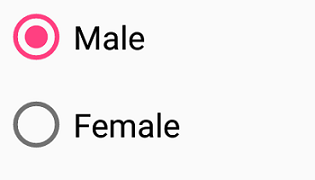Getting Started with Xamarin Radio Button (SfRadioButton)
21 Nov 20248 minutes to read
This section explains the steps required to configure the Xamarin Radio Button (SfRadioButton) control in a real-time scenario and provides a walk-through on some of the customization features available in SfRadioButton control.
Assembly deployment
After installing Essential Studio® for Xamarin, you can find all the required assemblies in the installation folders, {Syncfusion Essential Studio Installed location} \Essential Studio\{Version #}\Xamarin\lib.
E.g.: C:\Program Files (x86) \Syncfusion\Essential Studio\19.1.0.54\Xamarin\lib
NOTE
Assemblies can be found in unzipped package location(Documents/Syncfusion/{Version #}/Xamarin/lib) in Mac.
Adding SfRadioButton reference
You can add SfRadioButton reference using one of the following methods:
Method 1: Adding SfRadioButton reference from nuget.org
Syncfusion Xamarin components are available in nuget.org. To add SfRadioButton to your project, open the NuGet package manager in Visual Studio, search for Syncfusion.Xamarin.Buttons, and then install it.

NOTE
- Install the same version of SfRadioButton NuGet in all the projects.
- In addition, you need to install the Syncfusion.Xamarin.Buttons.WPF package for Xamarin.Forms WPF platform only.
Method 2: Adding SfRadioButton reference from toolbox
Syncfusion also provides Xamarin Toolbox. Using this toolbox, you can drag the SfRadioButton control to the XAML page. It will automatically install the required NuGet packages and add the namespace to the page. To install Syncfusion Xamarin Toolbox, refer to Toolbox.
Method 3: Adding SfRadioButton assemblies manually from the installed location
If you prefer to manually reference the assemblies instead referencing from NuGet, add the following assemblies in respective projects.
Location: {Installed location}/{version}/Xamarin/lib
| PCL | Syncfusion.Buttons.XForms.dll Syncfusion.Core.XForms.dll Syncfusion.Licensing.dll |
| Android | Syncfusion.Buttons.XForms.dll Syncfusion.Buttons.XForms.Android.dll Syncfusion.Core.XForms.dll Syncfusion.Core.XForms.Android.dll Syncfusion.Licensing.dll |
| iOS | Syncfusion.Buttons.XForms.dll Syncfusion.Buttons.XForms.iOS.dll Syncfusion.Core.XForms.dll Syncfusion.Core.XForms.iOS.dll Syncfusion.Licensing.dll |
| UWP | Syncfusion.Buttons.XForms.dll Syncfusion.Buttons.XForms.UWP.dll Syncfusion.Core.XForms.dll Syncfusion.Core.XForms.UWP.dll Syncfusion.Licensing.dll |
| WPF | Syncfusion.Buttons.XForms.dll Syncfusion.Buttons.XForms.WPF.dll Syncfusion.Core.XForms.dll Syncfusion.Core.XForms.WPF.dll Syncfusion.Licensing.dll |
NOTE
To know more about obtaining our components, refer to these links for Mac and Windows.
IMPORTANT
Starting with v16.2.0.x, if you reference Syncfusion assemblies from the trial setup or from the NuGet feed, you also have to include a license key in your projects. Please refer to Syncfusion license key to know about registering Syncfusion license key in your Xamarin application to use our components.
NOTE
After adding the assembly reference, an additional step is required for iOS and UWP projects. If you are adding the references from toolbox, this step is not needed.
Additional step for iOS
To launch SfRadioButton in iOS, call the SfRadioButtonRenderer.Init() in FinishedLaunching overridden method of AppDelegate class in iOS Project, as demonstrated in the following code example.
public override bool FinishedLaunching(UIApplication app, NSDictionary options)
{
global::Xamarin.Forms.Forms.Init();
LoadApplication(new App());
Syncfusion.XForms.iOS.Buttons.SfRadioButtonRenderer.Init();
return base.FinishedLaunching(app, options);
}Additional step for UWP
This step is required only if the application is deployed in Release mode with .NET native tool chain enabled. It is for resolving the known Framework issue “Custom controls not rendering in Release mode” in UWP platform. Initializing the SfRadioButton assembly at OnLaunched overridden method of the App class in UWP project is the suggested work around, as demonstrated in the following code example.
protected override void OnLaunched(LaunchActivatedEventArgs e)
{
.....
rootFrame.NavigationFailed += OnNavigationFailed;
// Add `using System.Reflection;`
List<Assembly> assembliesToInclude = new List<Assembly>();
//Now, add all the assemblies that your app uses
assembliesToInclude.Add(typeof(SfRadioButtonRenderer).GetTypeInfo().Assembly);
// replaces Xamarin.Forms.Forms.Init(e);
Xamarin.Forms.Forms.Init(e, assembliesToInclude);
.....
}Additional step for WPF
To launch the radio button in WPF, call the SfRadioButtonRenderer.Init() method in the MainWindow constructor of the MainWindow class after the Xamarin.Forms framework has been initialized and before the LoadApplication method is called as demonstrated in the following code sample.
public partial class MainWindow : FormsApplicationPage
{
public MainWindow()
{
InitializeComponent();
Forms.Init();
Syncfusion.XForms.WPF.Buttons.SfRadioButtonRenderer.Init();
LoadApplication(new App());
}
}Create a Simple SfRadioButton
The SfRadioButton control is configured entirely in C# code or by using XAML markup. The following steps explain how to create a SfRadioButton and configure its elements.
Add namespace for referred assemblies
xmlns:syncfusion="clr-namespace:Syncfusion.XForms.Buttons;assembly=Syncfusion.Buttons.XForms"using Syncfusion.XForms.Buttons;Refer SfRadioButton control with declared suffix name for Namespace
<?xml version="1.0" encoding="utf-8">
<ContentPage xmlns="http://xamarin.com/schemas/2014/forms"
xmlns:x="http://schemas.microsoft.com/winfx/2009/xaml"
xmlns:local="clr-namespace:GettingStarted"
xmlns:syncfusion="clr-namespace:Syncfusion.XForms.Buttons;assembly=Syncfusion.Buttons.XForms"
x:Class="GettingStarted.MainPage">
<ContentPage.Content>
<StackLayout>
<syncfusion:SfRadioButton x:Name="radioButton"/>
</StackLayout>
</ContentPage.Content>
</ContentPage>using Syncfusion.XForms.Buttons;
using Xamarin.Forms;
namespace GettingStarted
{
public partial class MainPage : ContentPage
{
public MainPage()
{
InitializeComponent();
StackLayout stackLayout = new StackLayout();
SfRadioButton radioButton = new SfRadioButton();
stackLayout.Children.Add(radioButton);
this.Content = stackLayout;
}
}
}Setting caption
The radio button caption can be defined using the Text property of SfRadioButton. This caption normally describes the meaning of the radio button and it displays next to radio button.
<syncfusion:SfRadioButton x:Name="radioButton" Text="RadioButton"/>SfRadioButton radioButton = new SfRadioButton();
radioButton.Text = "RadioButton";
This demo can be downloaded from this link.
Change the radio button state
The two different visual states of the SfRadioButton are:
- Checked
- Unchecked
You can change the state of the radio button using the IsChecked property of SfRadioButton. In the checked state, an inner circle is added to the visualization of radio button.
The radio buttons are used when there is a list of two or more options or group that are mutually exclusive and the user must select exactly one choice, such as “Select Gender” or “Choose the best option!”.
<syncfusion:SfRadioGroup x:Name="radioGroup">
<syncfusion:SfRadioButton x:Name="male" Text="Male" IsChecked="True"/>
<syncfusion:SfRadioButton x:Name="female" Text="Female"/>
</syncfusion:SfRadioGroup>SfRadioGroup radioGroup = new SfRadioGroup();
SfRadioButton male = new SfRadioButton();
male.IsChecked = true;
male.Text = "Male";
SfRadioButton female = new SfRadioButton();
female.Text = "Female";
radioGroup.Children.Add(male);
radioGroup.Children.Add(female);NOTE
SfRadioButtonsare mutually exclusive among them when they are defined withinSfRadioGroup.

This demo can be downloaded from this link.